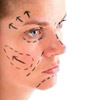Taking unpleasant surprises out of cosmetic surgery
For some plastic surgery patients, expectations are unrealistically high. Basing their hopes on the before-and-after albums offered in surgeons’ offices, they expect to achieve a perfect body or to look just like a favorite celeb. But those albums only show how someone else’s liposuction, breast augmentation, or Beyonce bum enhancement turned out.
Now a Tel Aviv University researcher is developing software based on real clinical data to give patients a more accurate – and three-dimensional – before-and-after picture before the scalpel comes down. Tackling a very difficult mathematical problem in computer modelling called predicting “deformations” of non-rigid objects, Dr Alex Bronstein of Tel Aviv University’s Department of Electrical Engineering and his partners have built a tool that can generate an anatomically accurate after-surgery image.
With the help of experienced plastic surgeons, the tool can work like a engine to retrieve geometric objects in the same manner Google retrieves web pages. It helps patients avoid unexpected results in the plastic surgeon’s office, and can also help a surgeon determine the most favourable outcome for the patient.
A virtual mirror trumps Photoshop
Current image-prediction software only generates two-dimensional images, and its processing power is limited to relatively simple image processing programs like Photoshop. “Our program is more like a virtual mirror. It gives surgeons and their patients a way to see a 3D before-and-after image as though the patient has really undergone the operation,” says Dr Bronstein, who works with his identical twin, Michael Bronstein and Prof. Ron Kimmel from the Technion, on the research. The trio have authored a number of research papers on the topic, most recently in ACM Transactions on Graphics and SIAM.
The Bronsteins’ twinship spurred them to do the original research on this topic, after their academic and PhD supervisor Ron Kimmel from the Technion in Israel challenged them to build a device that could tell identical twins apart. The Bronsteins met the challenge – the results of their basic research were featured on CNN and have led to their investigating a dozen or so applications.
For this application, the researchers applied data from past plastic surgery patients and considered a number of variables, such as the patients’ ages and different tissue types.
The third dimension is the most important
Following rigorous interviews with internationally respected plastic surgeons, Dr Bronstein designed the program with the help of numerous pre- and post-surgery images fed into a computer to “teach” it to more accurately generate post-surgery images. Now under commercial development, the software will not only show women and men a much more accurate outcome, but also help surgeons achieve more favourable results for their clientele, the researchers say.
A significant challenge was creating an algorithm that could generate a 3D image from a 2D picture. Today’s photographic equipment can “see” and represent the human body from only one angle. Working with his colleagues, Dr Bronstein integrated multiple 2D images into a single computer program that results in a 3D output.
Tools like theirs will become even more accessible, affordable and powerful in the coming years as consumer 3D video cameras become more widespread, Dr Bronstein predicts. He adds that the same premise can be used by people in weight-loss programs – as a predictor of their body image after they’ve shed excess pounds.
(Source: Tel Aviv University)
More information
 | For more information, see Cosmetic Surgery: An Introduction. |
Dates
Created by:

 Login
Login














